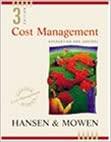David Christensen, plant manager, was given the charge to produce 120,000 bolts used in the manufacture of
Question:
David Christensen, plant manager, was given the charge to produce 120,000 bolts used in the manufacture of small twin engine aircraft. Directed by his divisional manager to give the bolt production priority over other jobs, he had two weeks to produce the units. Meet¬
ing the delivery date was crucial for renewal of a major contract with a large airplane man¬
ufacturer. Each bolt requires 20 minutes of direct labor and 5 ounces of metal. After pro¬
ducing a batch of bolts, each bolt is subjected to a stress test. Those that pass are placed in a carton, which is stamped "Inspected by inspector no._" (the inspector's identification number is inserted). Defective units are discarded, having no salvage value. Because of the nature of the process, rework is not possible.
At the end of the first week, the plant had produced 60,000 acceptable units and used 24,000 direct labor hours, 4,000 hours more than the standard allowed. Furthermore, 65,000 total bolts had been produced and 5,000 had been rejected, creating an unfavorable materi¬
als usage variance of 25,000 ounces. David knew that a performance report would be prepared when the 120,000 bolts were completed. This report would compare the labor and materials used with that allowed. Any variance in excess of 5% of standard would be in¬
vestigated. David expected the same or worse performance for the coming week and was worried about a poor performance rating for himself. Accordingly, at the beginning of the second week, David moved his inspectors to the production line (all inspectors had pro¬
duction experience). However, for reporting purposes the production hours provided by in¬
spectors would not be counted as part of direct labor. They would still appear as a separate budget item on the performance report. Additionally, David instructed the inspectors to pack the completed bolts in the cartons and stamp them as inspected. One inspector ob¬
jected; David reassigned the inspector temporarily to material handling and gave an in¬
spection stamp with a fabricated identification number to a line worker who was willing to stamp the cartons of bolts as inspected.
Required:
1. Explain why David stopped inspections on the bolts and reassigned inspectors to pro¬
duction and material handling. Discuss the ethical ramifications of this decision.
2. What features in the functional-based responsibility accounting system provided the incentive(s) for David to take the actions described? Would an activity-based or strategic-based responsibility accormting system have provided incentives that dis¬
courage this kind of behavior? Explain.
3. What likely effect would David's actions have on the quality of the bolts? Was the decision justified by the need to obtain renewal of the contract, particularly if the plant returns to a normal inspection routine after the rush order is completed? Do you have any suggestions about the quality approach taken by this company? Explain why activity- or strategic-based responsibility accounting might play a useful role in this setting.
Step by Step Answer:

Cost Management Accounting And Control
ISBN: 9780324002324
3rd Edition
Authors: Don R. Hansen, Maryanne M. Mowen





